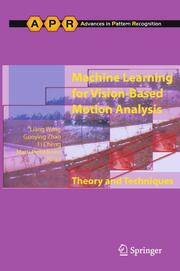Detailansicht
Machine Learning for Vision-based Motion Analysis
Theory and Techniques, Advances in Pattern Recognition, Advances in Computer Vision and Pattern Recognition
ISBN/EAN: 9780857290564
Umbreit-Nr.: 1037752
Sprache:
Englisch
Umfang: xiv, 372 S.
Format in cm:
Einband:
gebundenes Buch
Erschienen am 23.11.2010
Auflage: 1/2011
- Zusatztext
- InhaltsangabePart I: Manifold Learning and Clustering/SegmentationPractical Algorithms of Spectral Clustering: Toward Large-Scale Vision-Based Motion Analysis Tomoya Sakai, and Atsushi ImiyaRiemannian Manifold Clustering and Dimensionality Reduction for Vision-based Analysis Alvina GohManifold Learning for Multi-dimensional Auto-regressive Dynamical Models Fabio CuzzolinPart II: TrackingMixed-state Markov Models in Image Motion Analysis Tomás Crivelli, Patrick Bouthemy, Bruno Cernuschi Frías, and Jian-feng YaoLearning to Detect Event Sequences in Surveillance Streams at Very Low Frame Rate Paolo Lombardi, and Cristina VersinoDiscriminative Multiple Target Tracking Xiaoyu Wang, Gang Hua, and Tony X. HanA Framework of Wire Tracking in Image Guided Interventions Peng Wang, Andreas Meyer, Terrence Chen, Shaohua K. Zhou, and Dorin ComaniciuPart III: Motion Analysis and Behavior ModelingAn Integrated Approach to Visual Attention Modeling for Saliency Detection in Videos Sunaad Nataraju, Vineeth Balasubramanian, and Sethuraman PanchanathanVideo-based Human Motion Estimation by Part-whole Gait Manifold Learning Guoliang Fan, and Xin ZhangSpatio-temporal Motion Pattern Models of Extremely Crowded Scenes Louis Kratz and Ko NishinoLearning Behavioral Patterns of Time Series for Video-surveillance Nicoletta Noceti, Matteo Santoro, and Francesca OdonePart IV: Gesture and Action RecognitionRecognition of Spatiotemporal Gestures in Sign Language using Gesture Threshold HMMs Daniel Kelly, John Mc Donald and Charles MarkhamLearning Transferable Distance Functions for Human Action Recognition Weilong Yang, YangWang, and Greg Mori
- Kurztext
- Techniques of vision-based motion analysis aim to detect, track, identify, and generally understand the behavior of objects in image sequences. With the growth of video data in a wide range of applications from visual surveillance to human-machine interfaces, the ability to automatically analyze and understand object motions from video footage is of increasing importance. Among the latest developments in this field is the application of statistical machine learning algorithms for object tracking, activity modeling, and recognition.Developed from expert contributions to the first and second International Workshop on Machine Learning for Vision-Based Motion Analysis, this important text/reference highlights the latest algorithms and systems for robust and effective vision-based motion understanding from a machine learning perspective. Highlighting the benefits of collaboration between the communities of object motion understanding and machine learning, the book discusses the most active forefronts of research, including current challenges and potential future directions.Topics and features: - Provides a comprehensive review of the latest developments in vision-based motion analysis, presenting numerous case studies on state-of-the-art learning algorithms Examines algorithms for clustering and segmentation, and manifold learning for dynamical models Describes the theory behind mixedstate statistical models, with a focus on mixedstate Markov models that take into account spatial and temporal interaction Discusses object tracking in surveillance image streams, discriminative multiple target tracking, and guidewire tracking in fluoroscopy Explores issues of modeling for saliency detection, human gait modeling, modeling of extremely crowded scenes, and behavior modeling from video surveillance data Investigates methods for automatic recognition of gestures in Sign Language, and human action recognition from small training sets Researchers, professional engineers, and graduate students in computer vision, pattern recognition and machine learning, will all find this text an accessible survey of machine learning techniques for vision-based motion analysis. The book will also be of interest to all who work with specific vision applications, such as surveillance, sport event analysis, healthcare, video conferencing, and motion video indexing and retrieval.Dr. Liang Wang is a lecturer at the Department of Computer Science at the University of Bath, UK, and is also affiliated to the National Laboratory of Pattern Recognition in Beijing, China. Dr. Guoying Zhao is an adjunct professor at the Department of Electrical and Information Engineering at the University of Oulu, Finland. Dr. Li Cheng is a research scientist at the Agency for Science, Technology and Research (A*STAR), Singapore. Dr. Matti Pietikäinen is Professor of Information Technology at the Department of Electrical and Information Engineering at the University of Oulu, Finland.
